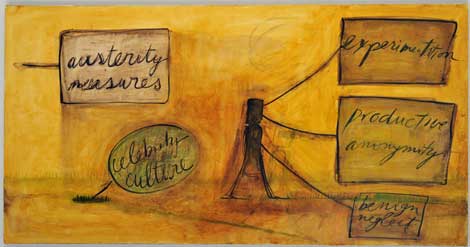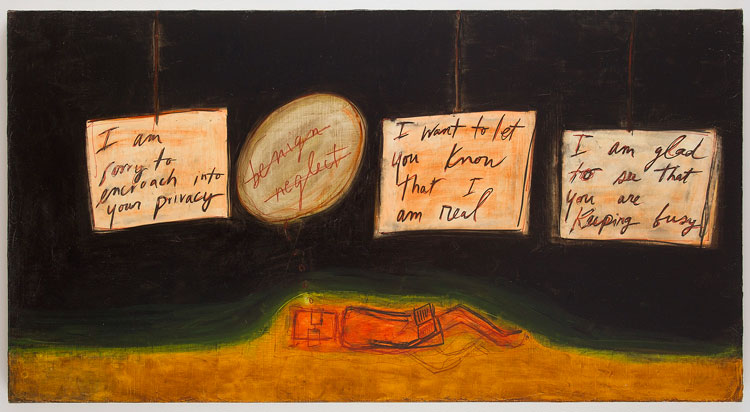Summer of 1965. The artist’s mother, Resia (also an artist), stands between her two daughters wearing a sleeveless shift with a bold daisy pattern. The horizon line of the Atlantic connects the heads of the three women, who pose, smiling and relaxed, in front of a long vista of open sea.
That horizon, those daisies are among the leitmotifs in Mira Schor’s show of new paintings and drawings at CB1 Gallery. “Chthonic Garden” comprises a green-filled and surprisingly optimistic body of work “given the incredible precarity we’re living in,” the artist comments as we sit in the elegant gallery space, part of the original 1915 lobby of the former Citizen’s Bank in downtown Los Angeles. Most of us know this feeling of precariousness, perfectly distilled in the painting The Ground, where Schor’s schematic figure (or “avatar,” as she calls it) hovers, simultaneously relaxed and destabilized. I love this ironic humor, which advises us to maintain balance, even if we are on the edge of our respective and collective unknowns. A lifelong New Yorker, the articulate and engaging artist talked about balance and precarity during our interview.
I first met Schor’s bespectacled stand-in three years ago in her 2010 show at CB1, “Paintings From the Nineties To Now.” Her newly created avatar was up and around, thought bubbles of dense black lines mirroring those in the open book she carried. Schor’s long-term interest in the interconnections between reading, thinking and painting was evident here, as in the earlier series, where single words, such as “flesh,” “trace” and “sign” are carved into thickly-textured oils.
In “Chthonic Garden,” the avatar has come into her own, inhabiting a lusher, more narrative realm, where handwritten words share her space, which may be above or below the horizon, or even inverted. “There is no upside down, we’re living in a topsy-turvy world,” Schor remarked in her well-attended gallery talk on opening night.
Are beauty and productivity underground or overground? Schor asks us; then complicates the answer. This interplay between above and below is key. Chthonic means underground and the concept of lying fallow has deep meaning for the artist. Her paintings—largely ink and oil on gesso on linen—suggest that underground can be a time/place of regeneration, contemplation and renewal. Schor’s fallow isn’t about being dormant, clearly. It’s a time of “productive anonymity,”which she aligns with “experimentation” and “benign neglect,” in opposition to “celebrity culture” and “austerity measures”—all words found in Conditions of Contemporary Practice. In the luscious, nocturnal Morning in America, we find the avatar nestled below ground like a seed, protected against so much hovering verbiage, dreaming of benign neglect (as in leave me alone vs. abandonment). But underground is not always fertile or productive. Sometimes the avatar is pitched into the earth or uprooted, like the 100-year-old tree near Schor’s apartment during Hurricane Sandy, another experience of collective precarity entering this body of work.
Above, below and sometimes upside down, daisies appear, bracketing the avatar like guardians, as in Underground Garden. Schor’s “goofy” flowers represent the “uncomplicated impulse of childhood drawings, like the houses children draw.” She elaborates: “It’s a happy visual pleasure, a design pleasure.” We reminisce about the Pop fabrics of Finnish design company Marimekko, and the purposely naïve pleasure of the big-daisy forms that Schor plants throughout “Chthonic Garden.”
Visual pleasure, and its possibility, is a consistent theme in both Schor’s artwork and writing (I recommend her collections of essays: Wet: On Painting, Feminism, and Art Culture and also A Decade of Negative Thinking: Essays on Art, Politics, and Daily Life). In Visual Pleasure/Productive Anonymity, the avatar sports sunglasses and sits beneath the shade of a schematic tree, reading “theory,” the floating square of “visual pleasure” joining the green space of reading/thinking with the world beyond. This co-habitation is significant, as too often in the poststructuralist-heavy decades of the 1980s and ’90s, “theory trumped visual pleasure” (to quote Ingrid Calame in conversation on opening night). In this series, Schor has, in her own words, “re-embraced the notion of visual pleasure and the sensuality of color.” Lying fallow and productive anonymity converge in this work: the latter is literally the ground on which the avatar rests. Celebrity culture is out of sight and the figure can relax and be fallow—this time above ground.

Mira Schor, Conditions of Contemporary Practice, 2013, Courtesy CB1 Gallery
Ink and oil on gesso on linen
These multilayered states of being explored in “Chthonic Garden” rely on premises antithetical to the air we breathe in today’s fast-paced, fame-driven culture. Schor suggests an alternative universe, one outside the finite state of being known—a deep-rooted and expanding universe of perpetual becoming.




